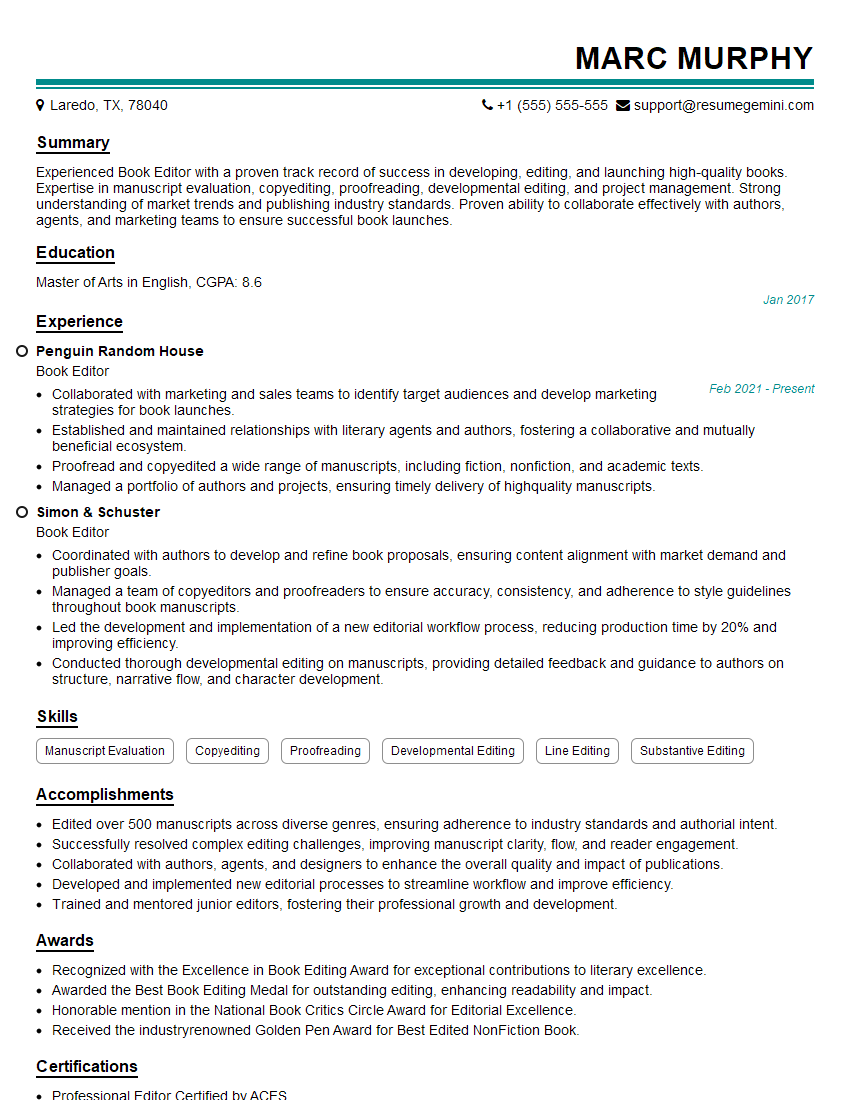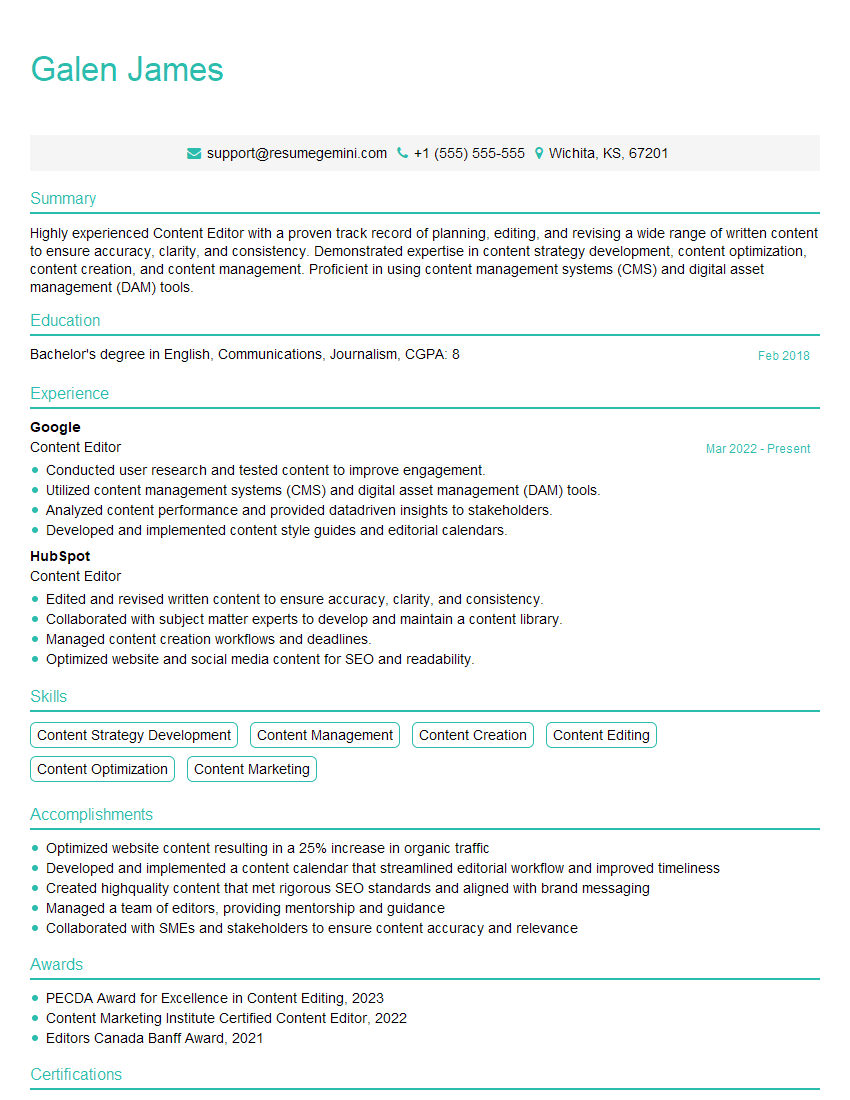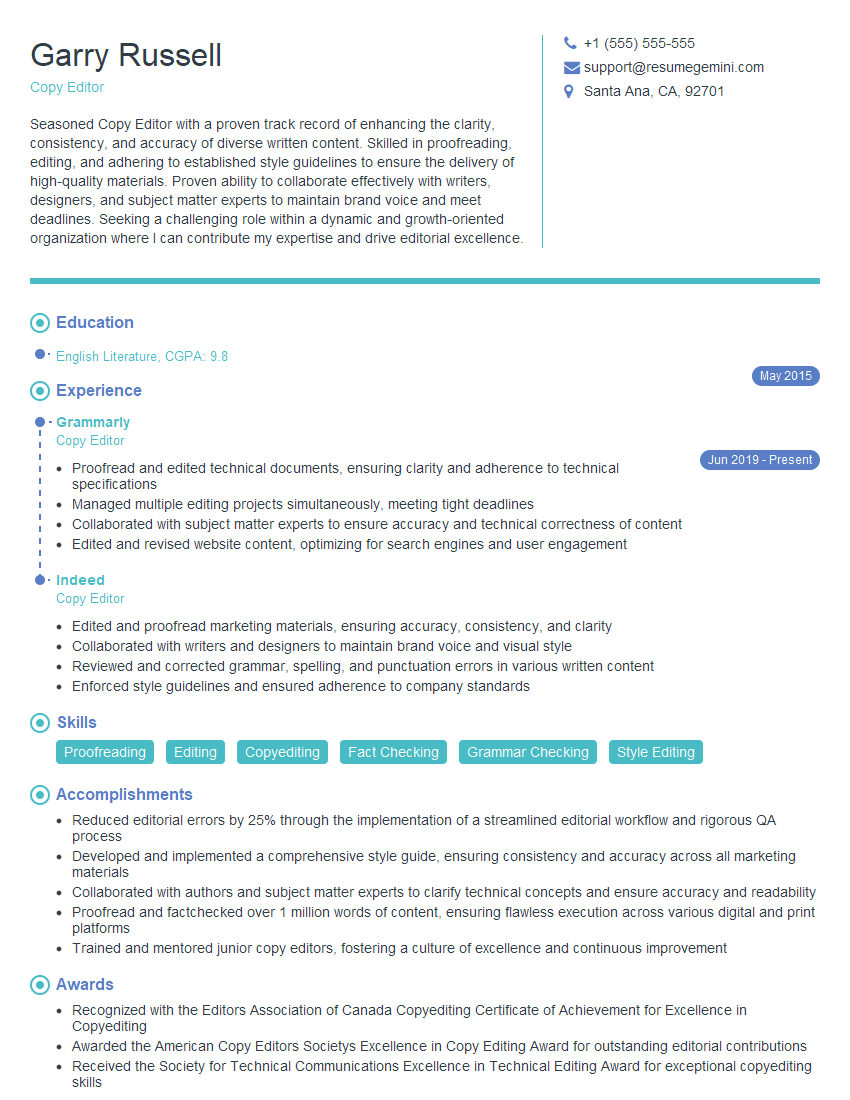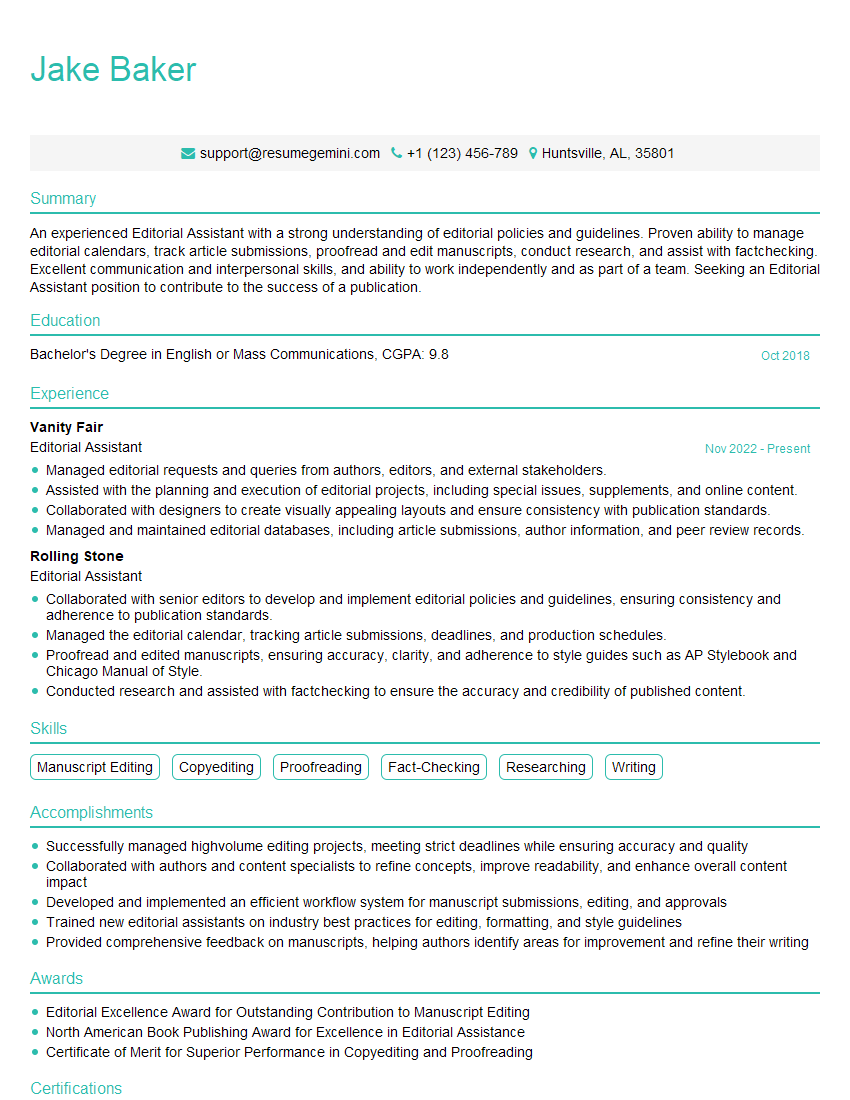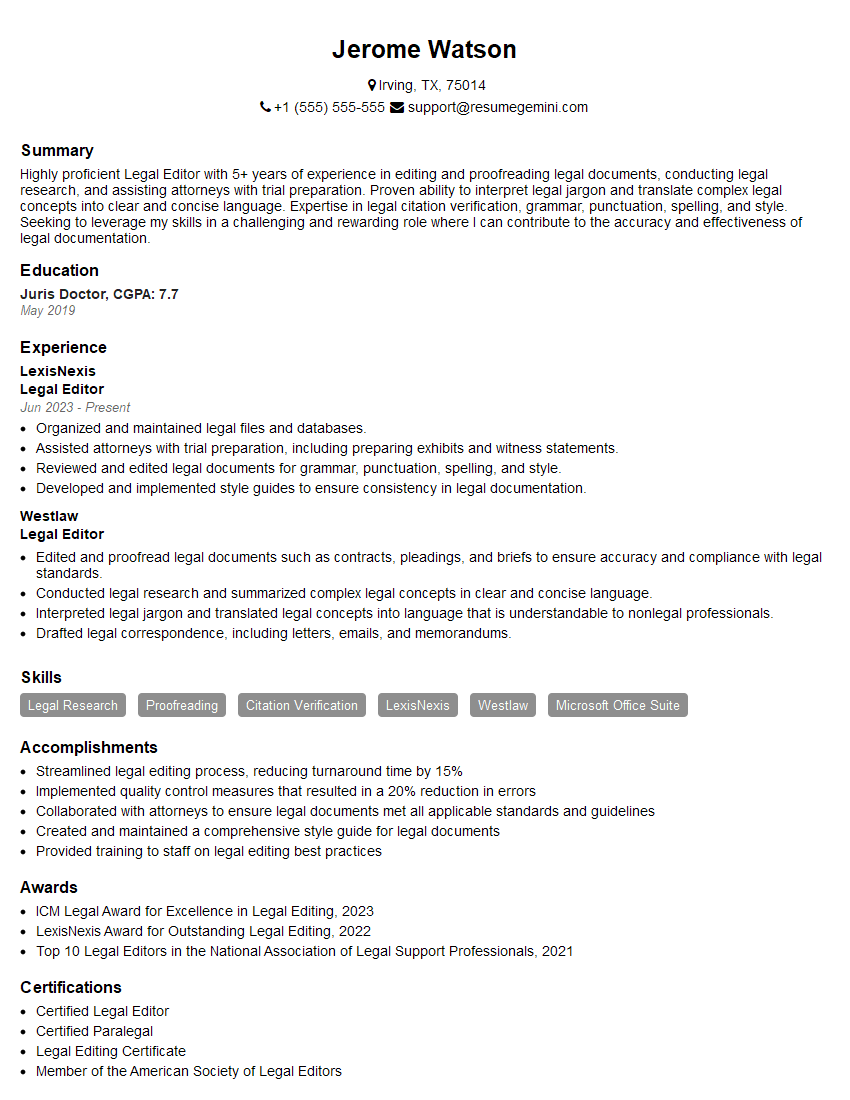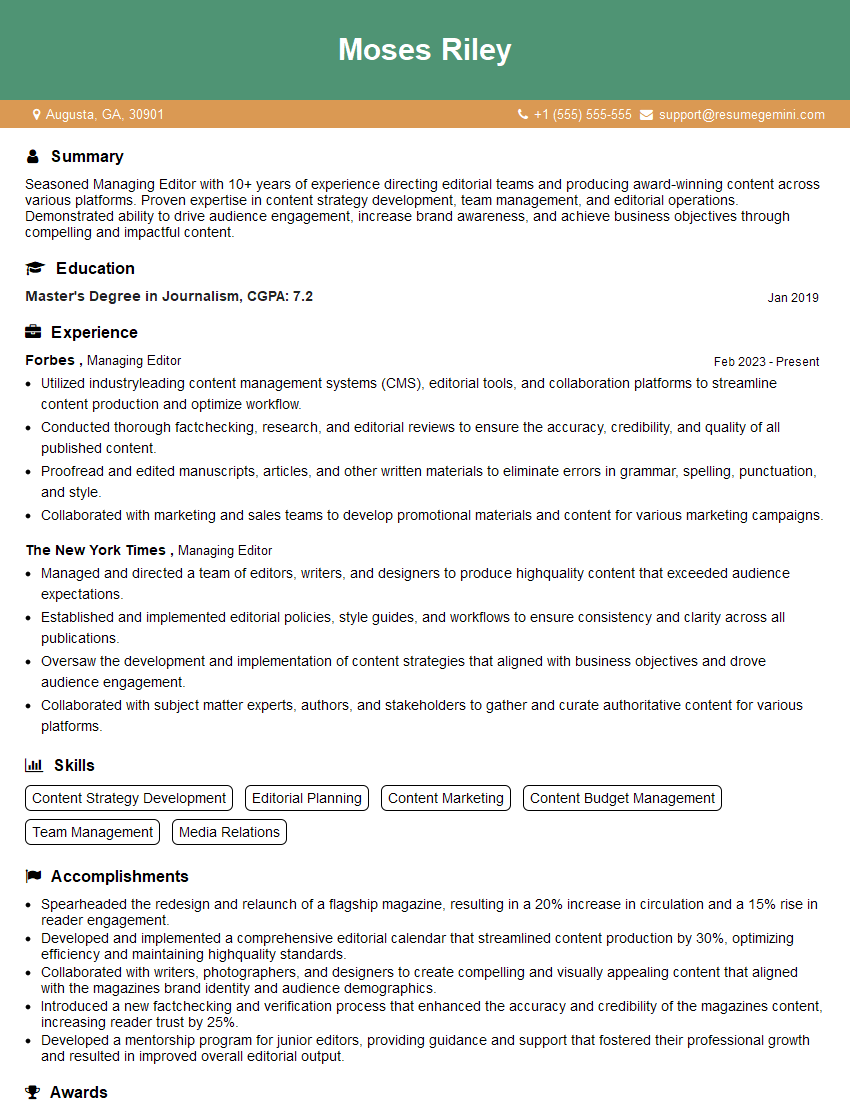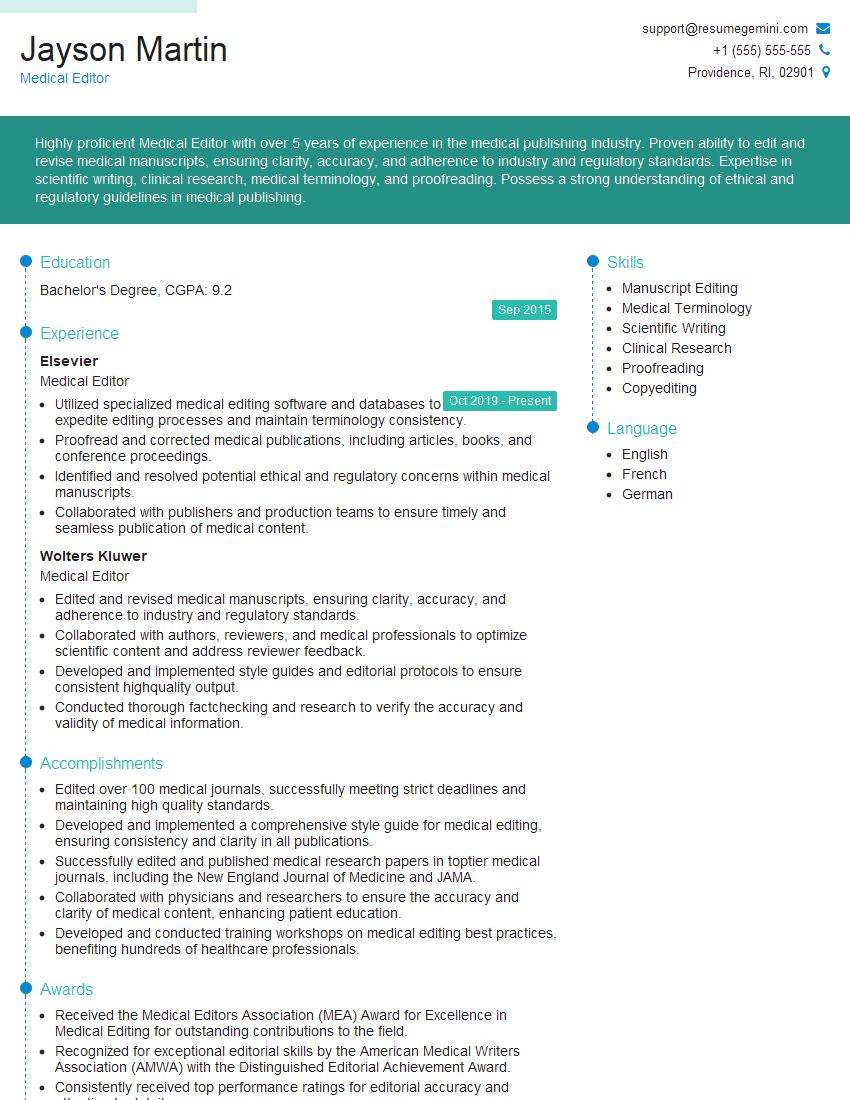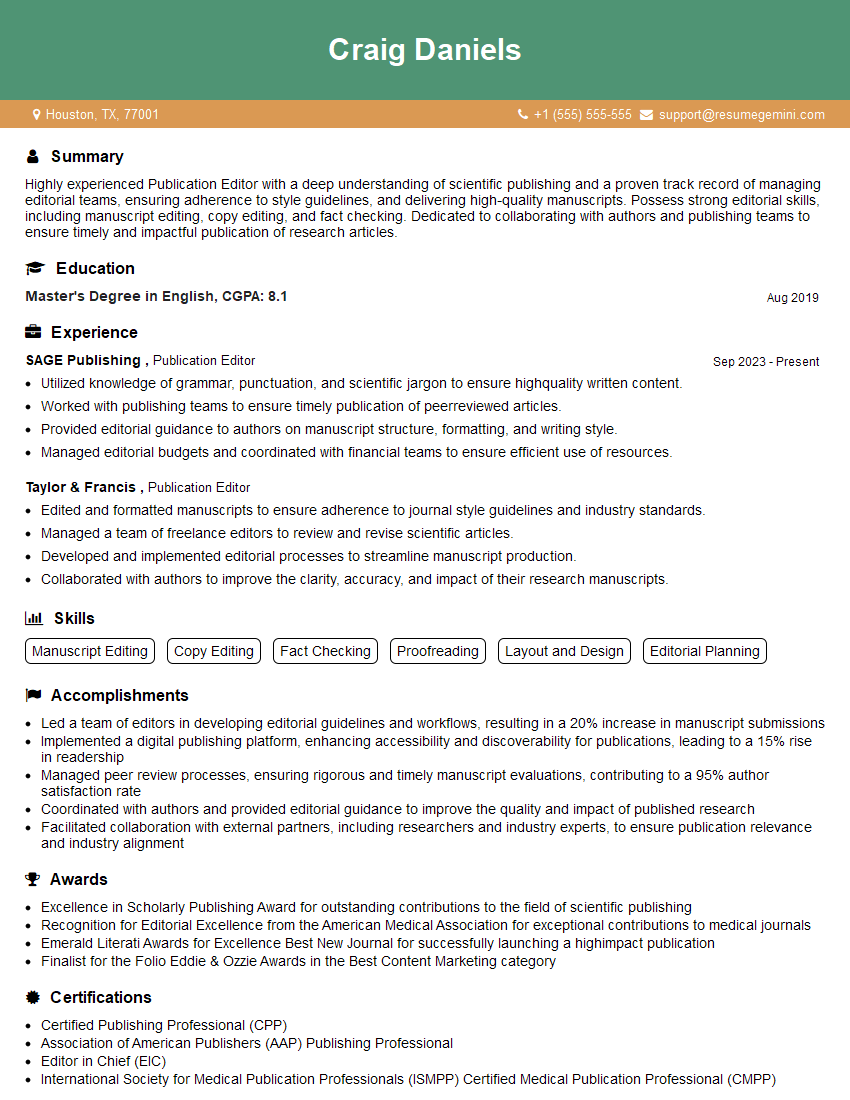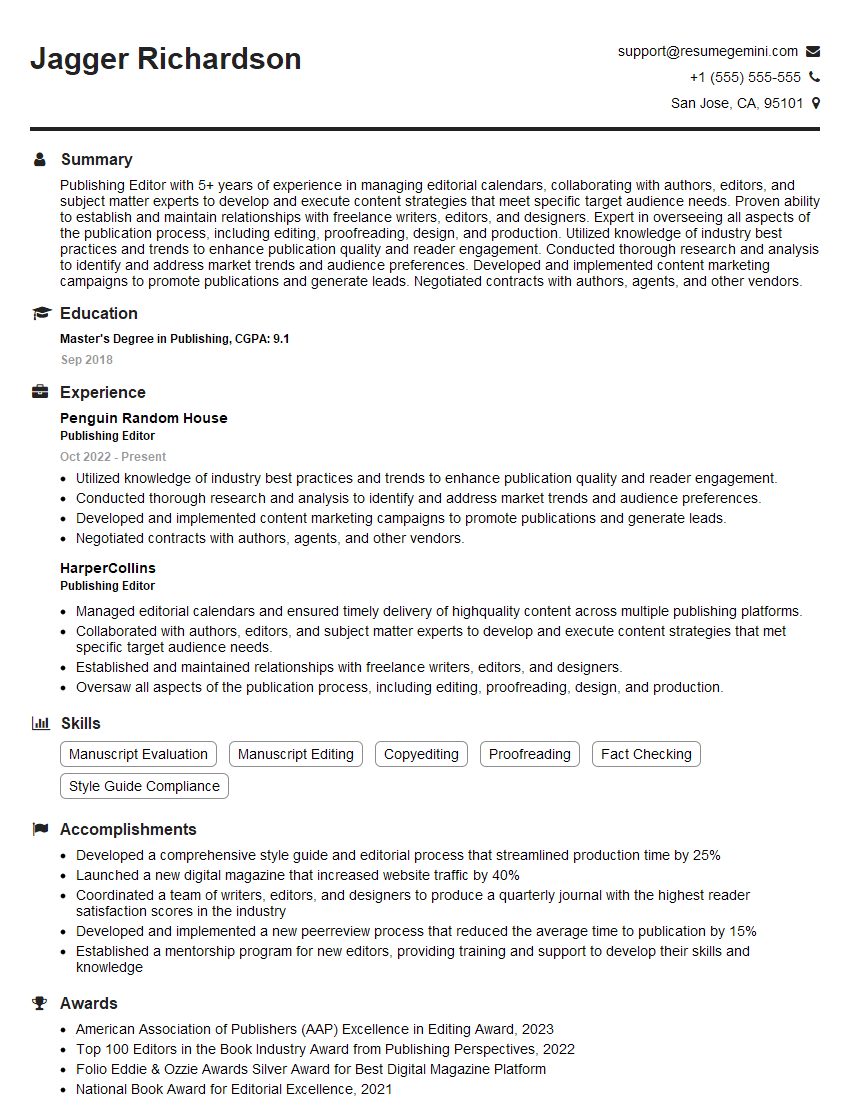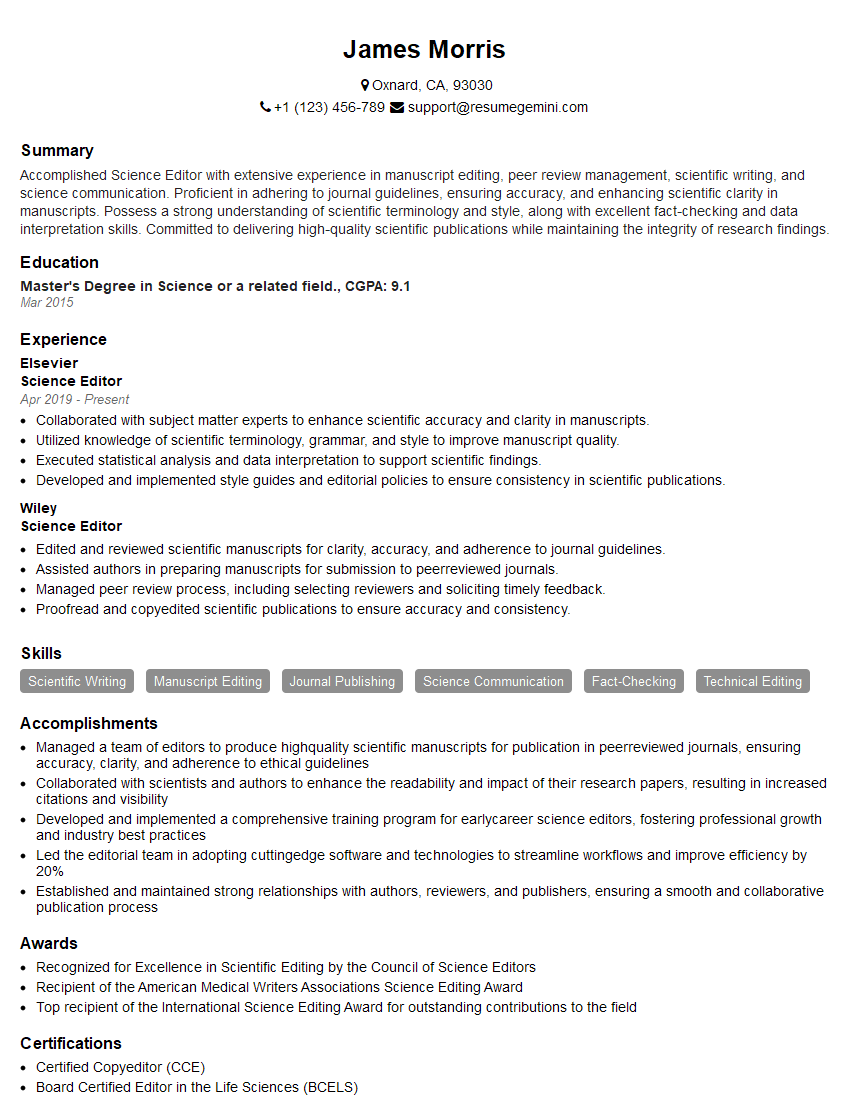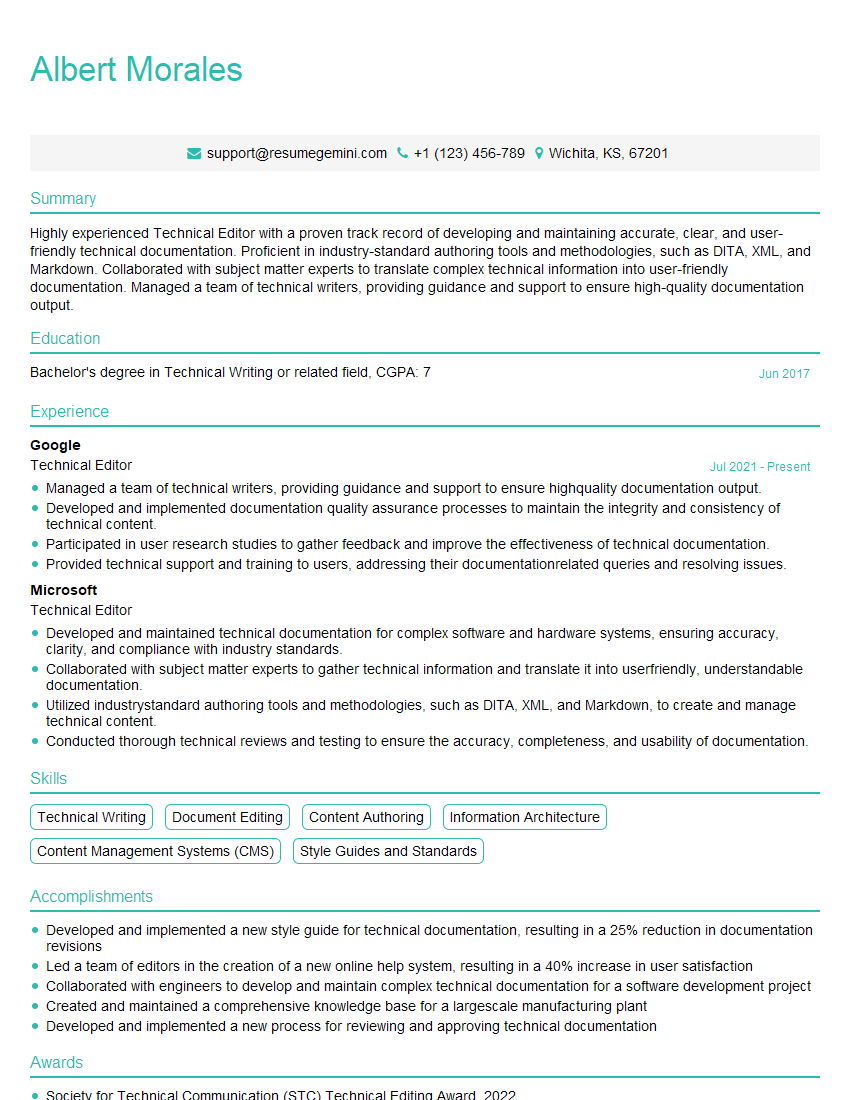The right preparation can turn an interview into an opportunity to showcase your expertise. This guide to Editing for Different Audiences interview questions is your ultimate resource, providing key insights and tips to help you ace your responses and stand out as a top candidate.
Questions Asked in Editing for Different Audiences Interview
Q 1. Explain your experience adapting writing style for various audiences (e.g., technical vs. general public).
Adapting writing style for different audiences is crucial for effective communication. It involves understanding the audience’s background knowledge, reading level, and interests, and then tailoring the language, tone, and structure of the writing accordingly. For example, a technical audience familiar with jargon can understand complex explanations, whereas a general audience requires simpler language and more context. I’ve worked extensively on both technical documentation (for software engineers, for instance, requiring precise terminology and detailed explanations) and popular science articles (demanding clear, concise language, engaging storytelling, and minimal technical jargon).
- Technical Audience: Precise, detailed, uses jargon, focuses on functionality and specifications.
- General Public: Clear, concise, avoids jargon, focuses on benefits and impact.
My experience involves shifting between these styles seamlessly, ensuring the message remains accurate and engaging, regardless of the audience’s expertise.
Q 2. How do you identify the target audience for a given piece of writing?
Identifying the target audience is the first and most crucial step. This involves analyzing the intended readership. I use a multi-faceted approach:
- Purpose of the writing: What is the goal? To inform, persuade, entertain? This shapes the audience’s expectations.
- Publication or platform: Where will this be published? A scientific journal will have a different audience than a blog or social media post.
- Client brief (if applicable): The client’s description of the intended readers.
- Demographics and psychographics: Age, education level, professional background, interests, values.
Often, I create a detailed audience persona – a fictional representation of the ideal reader – to help guide my editing decisions. For instance, a persona might be a 35-year-old marketing professional with a general understanding of technology, guiding my choices about technical language and explanation depth.
Q 3. Describe your process for ensuring clarity and accessibility across different reading levels.
Ensuring clarity and accessibility across reading levels involves employing several strategies:
- Sentence structure simplification: Breaking down complex sentences into shorter, clearer ones.
- Vocabulary adjustment: Replacing complex words with simpler synonyms or providing definitions for specialized terms.
- Active voice preference: Using active voice makes sentences more direct and easier to understand.
- Use of visuals: Incorporating charts, graphs, and images to break up text and convey information visually.
- Readability testing: Using tools like the Flesch-Kincaid readability test to assess the reading level and make adjustments as needed.
I also incorporate techniques to cater to diverse learning styles, including providing summaries, using headings and subheadings effectively, and structuring information logically to enhance comprehension.
Q 4. How do you tailor your editing approach based on the publication’s style guide and audience expectations?
Style guides and audience expectations are paramount. I meticulously review the specific publication’s style guide to ensure consistency in formatting, terminology, and tone. This goes beyond simply adhering to rules; it involves understanding the style guide’s rationale and how it aligns with the intended audience. For example, a scientific journal might have strict rules about referencing and formatting equations, while a blog might focus more on conversational tone and engaging storytelling.
Audience expectations are also considered; for instance, a highly formal publication necessitates a different tone than a casual, informal one. My approach involves a careful balancing act between meeting the stylistic requirements and ensuring the text remains clear and accessible to the target audience.
Q 5. Provide an example where you had to simplify complex information for a less technical audience.
I recently worked on a project explaining a complex algorithm used in financial modeling. The original document was dense with mathematical formulas and technical jargon. For a general audience article in a financial magazine, I translated the core concepts into plain language, using relatable analogies. For instance, instead of explaining complex derivatives, I used the example of buying a house with a mortgage to illustrate the underlying principles. I also removed unnecessary technical details and focused on the practical implications and benefits of the algorithm.
The result was an accessible and engaging article that accurately conveyed the essence of the algorithm without overwhelming the reader with technical specifics.
Q 6. How do you balance maintaining the author’s voice while ensuring clarity for the target audience?
Balancing author’s voice and audience clarity requires a delicate touch. It’s not about stripping away the author’s personality, but about refining their expression to improve its effectiveness for the target audience. I achieve this by:
- Identifying the author’s style: Understanding the author’s tone, vocabulary, and sentence structure.
- Strategic editing: Improving clarity without altering the overall message or voice.
- Collaboration with the author: Discussing any changes to ensure mutual understanding and acceptance.
Imagine an author with a highly academic style writing for a popular audience. I would work to maintain their intelligence and expertise, but replace overly technical language with accessible alternatives, while still preserving their distinctive writing style.
Q 7. Explain your experience editing for different media formats (e.g., print, web, social media).
Editing for different media formats demands adaptation. Each medium has its unique characteristics and audience expectations:
- Print: Focus on readability, consistent formatting, and thorough proofreading. The reader can take time to process the information.
- Web: Prioritizes scannability and clear visual hierarchy. Use of headings, subheadings, bullet points, and concise paragraphs are critical. Interactive elements and multimedia are often incorporated.
- Social Media: Requires brevity, impactful messaging, and strong calls to action. Character limits necessitate concise and engaging language. Visual elements are crucial.
My experience includes creating compelling social media copy from longer articles, adapting technical documentation for web accessibility, and ensuring print documents adhere to layout and design specifications. The key is understanding the limitations and opportunities of each medium and tailoring the message accordingly.
Q 8. How do you handle feedback from multiple stakeholders with differing perspectives on a piece of writing?
Managing feedback from multiple stakeholders with diverse perspectives requires a structured approach. Think of it like conducting an orchestra – each instrument (stakeholder) has a unique voice, and your job is to harmonize them into a cohesive whole. I begin by creating a centralized document to track all feedback, categorizing it by stakeholder and issue. This helps prevent information overload and ensures nothing gets lost. Then, I analyze the feedback, identifying areas of consensus and conflict. For conflicting viewpoints, I prioritize feedback based on the stakeholder’s expertise and the impact on the overall message. For example, if a subject-matter expert disagrees with a stylistic choice made by a marketing team member, I’ll generally favor the expert’s opinion on accuracy, but we can find a compromise on presentation. Finally, I communicate my decisions transparently, explaining the rationale behind each choice to maintain buy-in and collaboration.
For example, if one stakeholder wants a more formal tone while another prefers a casual tone, I might suggest a middle ground, perhaps using a semi-formal style with clear, concise language that’s accessible to a broader audience. The key is open communication and clear justification; stakeholder collaboration is far more effective than imposing my decisions unilaterally.
Q 9. Describe your experience working with diverse writing styles and adapting your approach accordingly.
Adapting to diverse writing styles is a cornerstone of my expertise. I’ve worked with everything from highly technical scientific papers to creative marketing copy, and each requires a different approach. I view each style as a unique dialect – possessing its own vocabulary, sentence structure, and overall tone. My process involves first understanding the author’s intent and the target audience. For example, a technical document demands precision and clarity, often employing passive voice and specific terminology, whereas a blog post might favor active voice, shorter sentences, and a more conversational tone. I adjust my editing strategies to match. For technical writing, I’ll focus on accuracy, consistency in terminology, and clarity of complex information. In contrast, for creative writing, I’ll focus on strengthening the narrative flow, enhancing the voice, and ensuring the overall impact is engaging.
I’ve even adapted my editing for different cultural contexts, recognizing that humor and word choices that work well in one culture might be offensive or confusing in another. I often consult cultural guides or experts when working on content targeting a culturally diverse audience to ensure I am aware of and respect cultural nuances.
Q 10. How do you ensure consistency in tone and style throughout a document intended for a diverse audience?
Maintaining consistency in tone and style across a diverse audience requires a well-defined style guide. Think of it as a blueprint for your writing. Before starting the editing process, I carefully develop or select a style guide that aligns with the overall brand voice and target audience. This guide should clearly outline elements such as voice (formal, informal, humorous), sentence structure, punctuation, and terminology. I use this guide as a reference point throughout the editing process.
To ensure consistency, I also use automated tools like grammar and style checkers to identify inconsistencies. These are not foolproof but provide a great starting point. Then, a thorough manual review is crucial, paying close attention to the transition between sections and chapters, ensuring a smooth and unified reading experience. This includes consistently using headings, subheadings, lists, and other formatting to maintain a structured flow. Additionally, I maintain a glossary of terms to ensure consistent usage of key vocabulary, preventing confusion across the document.
Q 11. How familiar are you with different style guides (e.g., AP, Chicago, MLA)?
I am highly proficient in several style guides including the Associated Press (AP) Stylebook, the Chicago Manual of Style, and the Modern Language Association (MLA) Handbook. Each guide serves a different purpose and governs different forms of writing. AP style is widely used in journalism and emphasizes brevity and clarity. Chicago style is favored in academic publishing and offers detailed guidance on formatting and citation. MLA style is commonly used in humanities disciplines and provides specific rules for research papers. My familiarity extends beyond simply following rules; I understand the underlying rationale behind each guide’s conventions and can adapt to specific requirements effectively. This understanding allows me to make informed decisions that maintain consistency and professionalism in all my work, regardless of the chosen style.
Q 12. Describe your process for reviewing and editing visual content (e.g., charts, images) for diverse audiences.
Editing visual content for diverse audiences demands a similar level of attention to detail as text editing. My approach starts with considering the accessibility and cultural appropriateness of the visual elements. Charts and graphs, for instance, need clear labeling, concise titles, and easily understood data representations to avoid misinterpretations across various levels of understanding and cultural backgrounds. Images should be carefully vetted for potential biases or cultural insensitivity. A photograph that is acceptable to one group may be offensive or misrepresentative to another. I frequently use alt text to make images accessible to users with visual impairments. The descriptions provided should convey the essence of the image effectively to screen readers.
Furthermore, I examine the visual hierarchy, making sure the most important information is presented clearly and prominently. This might involve adjusting color schemes, font sizes, or layout to improve readability and overall visual appeal, ensuring the communication is accessible and effective for everyone.
Q 13. How do you use data and analytics to inform your editing decisions for different audiences?
Data and analytics play a significant role in informing my editing decisions. Website analytics, for example, can provide insights into reader behavior, such as which sections of a document are most frequently read and which are skipped. This information helps me understand what resonates with the audience and what might need clarification or improvement. I can also use A/B testing to compare different versions of text or visuals, gauging reader engagement and preference. This data-driven approach enables me to make informed choices regarding tone, length, style, and even the overall structure of the document to maximize its impact and effectiveness.
For example, if analytics show a high bounce rate on a particular section, I might revise that section for improved clarity or reorganize it to make it more engaging.
Q 14. How do you identify and address potential biases in written content targeting diverse audiences?
Identifying and addressing biases in content is crucial for ethical and inclusive communication. My approach begins with a critical self-reflection on my own potential biases. I then conduct a thorough review of the content, looking for language or imagery that could perpetuate stereotypes, marginalize specific groups, or promote unfair representations. This includes examining word choices, character portrayals, and the overall narrative. For example, terms that may appear neutral in some contexts can carry significant negative connotations for others. Avoiding generalizations and focusing on individual characteristics instead promotes inclusive storytelling.
Once identified, I work to revise the content to remove or mitigate the biases. This might involve substituting potentially offensive language, adding diverse perspectives, or restructuring the narrative to ensure a more balanced and representative portrayal of different groups. It’s an iterative process that demands constant vigilance and a commitment to inclusive representation.
Q 15. How do you use editing to promote inclusivity and avoid harmful stereotypes?
Promoting inclusivity and avoiding harmful stereotypes in editing requires a conscious and multifaceted approach. It’s about ensuring representation and avoiding perpetuating biases that marginalize certain groups.
- Representation Matters: Actively seek out diverse voices and perspectives. This includes ensuring fair representation of different genders, ethnicities, sexual orientations, abilities, and socioeconomic backgrounds. Avoid using language that excludes or stereotypes any group.
- Careful Word Choice: Replace biased or outdated terminology. For example, instead of using ‘handicapped,’ use ‘person with a disability.’ Instead of ‘mankind,’ consider ‘humankind’ or ‘people.’ Avoid generalizations about entire groups.
- Contextual Sensitivity: Consider the historical and cultural context of the language used. What might be acceptable in one context could be deeply offensive in another.
- Perspective-Taking: Imagine yourself as a member of the groups represented in the text. Would the language used feel respectful and inclusive? Would it be empowering or marginalizing?
- Consult Experts: When in doubt, consult with individuals from the communities represented to ensure accuracy and avoid unintentional offense.
For example, if editing a historical document, instead of simply removing potentially offensive language, it’s often better to contextualize it with a footnote explaining the historical usage and its present-day implications.
Career Expert Tips:
- Ace those interviews! Prepare effectively by reviewing the Top 50 Most Common Interview Questions on ResumeGemini.
- Navigate your job search with confidence! Explore a wide range of Career Tips on ResumeGemini. Learn about common challenges and recommendations to overcome them.
- Craft the perfect resume! Master the Art of Resume Writing with ResumeGemini’s guide. Showcase your unique qualifications and achievements effectively.
- Don’t miss out on holiday savings! Build your dream resume with ResumeGemini’s ATS optimized templates.
Q 16. Describe your experience using tools to assist in accessibility editing (e.g., readability checkers).
Accessibility editing is crucial for ensuring that content is usable by everyone, regardless of their abilities. I frequently use tools to improve readability and accessibility. These include:
- Readability checkers: Tools like Hemingway Editor and Grammarly offer readability scores and highlight overly complex sentences. This helps ensure the text is easy to understand for a wider range of readers, including those with dyslexia or cognitive impairments.
- Style guides and checkers: These ensure consistent formatting and adherence to accessibility standards. For instance, WCAG (Web Content Accessibility Guidelines) provides specific criteria for web content accessibility.
- Screen reader compatibility software: I test edited content using screen readers to identify any accessibility issues such as missing alt text for images or poorly structured headings. This allows me to check that the content functions properly for those using assistive technologies.
For example, I recently used a readability checker to simplify a complex scientific paper for a broader audience. The checker identified overly long sentences and jargon, which I then revised to make the content more accessible.
Q 17. How do you incorporate audience feedback into your editing process?
Audience feedback is vital for effective editing. It provides valuable insights into how the target audience receives and interprets the content. I incorporate audience feedback through:
- Surveys and questionnaires: Gathering data on comprehension, engagement, and areas of confusion.
- Focus groups and user testing: Observing audience reactions to the content in real-time.
- Social media monitoring: Tracking online discussions and reactions to published content.
- Direct feedback mechanisms: Providing clear ways for the audience to submit their feedback.
I analyze feedback to identify recurring themes and patterns. This informs revisions, focusing on areas that need clarification, simplification, or restructuring. For instance, if feedback consistently highlights confusion around a specific section, I rewrite it for clarity.
Q 18. How do you prioritize edits based on audience needs and content goals?
Prioritizing edits depends on audience needs and content goals. I use a tiered approach:
- Accuracy and clarity: Fact-checking, correcting grammatical errors, and ensuring the message is easily understood. This is always the highest priority, as it forms the foundation of effective communication.
- Audience engagement: Ensuring the content resonates with the intended audience. This might involve adjusting the tone, style, or examples used.
- Content goals: Aligning the edits with the overall purpose of the content. This could involve optimizing for SEO, readability, or persuasive impact.
For example, when editing a marketing brochure, I might prioritize strong calls to action and clear benefits statements to meet marketing goals, whereas when editing a scientific journal article, accuracy and clarity of scientific findings would be paramount.
Q 19. How do you handle conflicting information from different sources while editing for a diverse audience?
Handling conflicting information from different sources requires careful evaluation and verification. My approach is:
- Source verification: Assessing the credibility and reliability of each source. Is it peer-reviewed? Is the author an expert? Is the information consistent with other reputable sources?
- Fact-checking: Cross-referencing information with multiple sources to ensure accuracy.
- Bias identification: Recognizing potential biases in different sources and considering their impact on the information presented.
- Transparency: When conflicts cannot be resolved, acknowledging the uncertainty and potential biases in the text.
For instance, when editing a piece on a controversial topic, I might highlight areas of ongoing debate and present multiple perspectives, ensuring fair representation of different viewpoints.
Q 20. Explain your approach to editing content for different cultural contexts.
Editing for different cultural contexts involves a deep understanding of cultural nuances, sensitivities, and values. This includes:
- Cultural awareness training: Familiarizing myself with the cultural norms and expectations of the target audience.
- Language adaptation: Avoiding idioms, slang, or expressions that may not translate well or be understood across different cultures.
- Image selection: Ensuring images are culturally appropriate and avoid stereotypes.
- Consultations: Collaborating with subject matter experts familiar with the specific culture.
For example, when editing a piece for an Asian audience, I might avoid Western-centric expressions and ensure that any references to historical events or cultural practices are accurate and sensitive.
Q 21. Describe a time you had to make a difficult editing decision to balance audience needs and author intent.
I once had to edit a memoir where the author recounted a deeply personal and potentially controversial event. The author’s intention was to present their experience honestly, but some details could have been interpreted as insensitive or hurtful to others involved. Balancing the author’s intent with the potential impact on readers was challenging.
My solution involved careful rewriting and contextualization. I preserved the essence of the author’s experience but adjusted the language to be more nuanced and sensitive. I worked closely with the author to explore alternative ways of expressing the events, finding wording that conveyed the author’s emotions without causing unnecessary harm. This involved many discussions and revisions, ensuring that the final product was both honest and respectful of all parties involved. It was a delicate balance, but ultimately, we produced a memoir that was both impactful and responsible.
Q 22. How do you ensure SEO best practices are integrated while editing for a specific audience?
Integrating SEO best practices while editing for a specific audience requires a nuanced approach. It’s not just about keyword stuffing; it’s about understanding the audience’s search intent and crafting content that naturally incorporates relevant keywords.
- Keyword Research: Before editing, I research keywords relevant to the target audience and the content’s topic. Tools like SEMrush or Ahrefs help identify high-volume, low-competition keywords. For example, editing a blog post about ‘dog training’ for first-time dog owners might involve using keywords like ‘puppy training tips’ or ‘basic obedience training’ instead of highly competitive terms.
- On-Page Optimization: This includes optimizing title tags, meta descriptions, header tags (H1-H6), and image alt text with relevant keywords. The language used must resonate with the target audience. For instance, a technical document’s title tags would differ significantly from a blog post aimed at the general public.
- Content Structure: Clear, concise writing, broken down with headings, subheadings, and bullet points improves readability and SEO. This structure also benefits the user experience, which is crucial for SEO.
- Audience-Specific Language: Using the vocabulary and tone appropriate for the target audience enhances engagement and search visibility. A piece targeting pet owners will use a different tone than one aimed at veterinary professionals.
For example, when editing a website for a luxury car dealership targeting high-net-worth individuals, I’d focus on keywords like ‘luxury vehicles,’ ‘prestige automobiles,’ and ‘high-performance cars,’ using sophisticated language and imagery reflecting the brand’s exclusivity.
Q 23. How do you manage multiple projects with different audiences and deadlines?
Managing multiple projects with diverse audiences and deadlines requires a robust organizational system and strong time-management skills. I rely on project management tools and a methodical approach.
- Project Management Software: I use tools like Asana or Trello to track deadlines, assign tasks, and monitor progress across all projects. Each project has its own board with individual cards for tasks, assigned to specific audiences.
- Prioritization: I prioritize tasks based on deadlines and importance, using methods like the Eisenhower Matrix (urgent/important) to allocate time effectively. This helps me focus on the most critical tasks for each audience.
- Time Blocking: I allocate specific time blocks for each project, ensuring sufficient time for research, editing, and review. This helps avoid multitasking and maintain focus.
- Clear Communication: Open communication with clients and stakeholders is crucial. I regularly update them on progress and address any concerns promptly.
For example, I might dedicate Monday mornings to editing technical documents, Tuesday afternoons to blog posts for a consumer audience, and Wednesday to reviewing website copy for a specific marketing campaign. This structured approach ensures all deadlines are met without compromising quality.
Q 24. Describe your proficiency with grammar and punctuation rules appropriate for different audiences.
My proficiency in grammar and punctuation extends beyond basic rules; I understand the nuances of style appropriate for different audiences. A formal report requires a different grammatical approach than a social media post.
- Formal vs. Informal: For formal audiences (e.g., academic papers, legal documents), I adhere strictly to grammar rules, using precise language and avoiding contractions. For informal audiences (e.g., blog posts, social media), a more relaxed style is appropriate, but still grammatically correct.
- Tone and Style Guides: I’m adept at following style guides (e.g., AP, Chicago) to ensure consistency. Each audience might have specific preferences; I carefully follow the style guide provided, or create one if needed.
- Audience-Specific Vocabulary: I tailor vocabulary and sentence structure to the audience’s comprehension level. Technical documents might include specialized terminology, while a children’s book will use simple, direct language.
For instance, when editing a research paper, I ensure precise subject-verb agreement and avoid colloquialisms. However, when editing a script for a comedic podcast, a slightly more informal tone and playful use of language might be appropriate.
Q 25. How do you maintain a high level of accuracy when editing for various audiences?
Maintaining accuracy across diverse audiences demands meticulous attention to detail and a systematic approach.
- Multiple Proofreads: I always conduct multiple proofreads, using different techniques like reading aloud or reverse reading to catch errors that might be missed on a first pass. I also use grammar and spell-check software as a first line of defense.
- Fact-Checking: For factual content, I diligently verify information from reliable sources. This is particularly crucial for technical documents or articles involving statistics or data.
- Style Consistency: I carefully maintain consistency in style, tone, and terminology throughout the document, regardless of the audience. This creates a professional and credible impression.
- Second Pair of Eyes: When possible, I seek a second opinion from a colleague or proofreader to catch any remaining errors. A fresh perspective often helps identify subtle issues.
For example, when editing a medical article, I would cross-reference all data and ensure accuracy by consulting peer-reviewed publications. The same rigorous approach would apply to a financial report.
Q 26. What strategies do you employ to ensure your edits are clear and concise for all audiences?
Ensuring clarity and conciseness across all audiences involves strategic writing techniques.
- Active Voice: I favor active voice for direct and engaging communication, which is generally preferred across all audiences. It makes the writing more dynamic and easier to understand.
- Short Sentences and Paragraphs: Keeping sentences and paragraphs concise improves readability. This is crucial for audiences with varying attention spans and literacy levels.
- Simple Language: I use clear, straightforward language, avoiding jargon or overly technical terms unless absolutely necessary and clearly defined for the target audience.
- Strong Verbs and Precise Nouns: Choosing strong verbs and precise nouns adds power and precision to the writing, making it more impactful for all audiences.
For instance, instead of writing ‘The report was completed by the team,’ I’d write ‘The team completed the report.’ This simple change improves clarity and conciseness.
Q 27. How would you approach editing a technical document for a non-technical audience?
Editing a technical document for a non-technical audience requires simplification and translation. It’s about conveying complex information in a way that’s easily understood without sacrificing accuracy.
- Plain Language: I replace technical jargon with plain language equivalents. Each technical term should be defined or replaced with a simpler explanation. For example, instead of ‘algorithm,’ I might use ‘set of rules’ depending on the context.
- Analogies and Metaphors: Using relatable analogies and metaphors can make complex concepts easier to grasp. This makes the information more accessible and engaging.
- Visual Aids: Incorporating visuals such as charts, graphs, or diagrams can significantly aid comprehension, especially for non-technical audiences.
- Simplified Structure: Breaking down complex information into smaller, digestible chunks with clear headings and subheadings enhances readability and improves the overall understanding of the document.
Imagine editing a technical manual on a new piece of software for an elderly user. I would avoid technical terminology and rely heavily on visual cues and simple explanations.
Q 28. Describe your experience collaborating with designers and other stakeholders to optimize content for different audiences.
Collaboration with designers and other stakeholders is essential to optimize content for different audiences. This collaborative effort ensures a cohesive and impactful message.
- Content Strategy Meetings: I participate in meetings to discuss the target audience, content goals, and design elements. This ensures alignment between content and visual design.
- Feedback Integration: I actively seek feedback from designers on content structure and readability. Their input on visual hierarchy and overall design improves the user experience.
- Accessibility Considerations: I collaborate with designers to ensure content is accessible to all audiences, including those with disabilities. This involves considerations such as alt text for images, proper heading structure, and color contrast.
- Testing and Iteration: I participate in user testing to assess the effectiveness of the content for the target audience and make revisions based on user feedback.
For example, when working on a website redesign, I’d collaborate closely with the designers to ensure the website’s content is well-integrated with the visual design, creating a seamless and user-friendly experience tailored to the intended audience.
Key Topics to Learn for Editing for Different Audiences Interview
- Understanding Your Audience: Analyze audience demographics, reading levels, and preferred communication styles (formal vs. informal, technical vs. lay). Consider how these factors influence word choice, tone, and overall message.
- Adapting Your Editing Style: Practical application: Demonstrate how you would edit the same piece of text differently for a scientific journal versus a blog post for a general audience. Highlight your ability to adjust your approach based on the target reader.
- Clarity and Conciseness: Master techniques for simplifying complex information, ensuring readability, and eliminating jargon or technical terms where inappropriate for the audience. Practice rewriting dense paragraphs to make them more accessible.
- Style Guides and Formatting: Discuss your experience with various style guides (AP, Chicago, MLA, etc.) and your ability to adapt to different formatting requirements based on the publication or platform.
- Ethical Considerations: Understand and articulate your approach to ensuring accuracy, avoiding bias, and maintaining the integrity of the original author’s voice while adapting for different audiences.
- Proofreading and Quality Control: Demonstrate understanding of the importance of meticulous proofreading and error detection across various media (print, web, social media). Be prepared to discuss your strategies for catching inconsistencies and typos.
- Collaboration and Feedback: Describe your experience working with authors, editors, and other stakeholders to ensure the final product meets the needs of the target audience and editorial standards.
Next Steps
Mastering the art of editing for different audiences is crucial for career advancement in publishing, journalism, content creation, and many other fields. It demonstrates adaptability, strong communication skills, and a deep understanding of effective writing. To significantly boost your job prospects, invest time in creating a strong, ATS-friendly resume that highlights your key skills and experience. ResumeGemini is a trusted resource to help you craft a professional and impactful resume that showcases your unique abilities. Examples of resumes tailored to Editing for Different Audiences are provided to guide your resume building process.
Explore more articles
Users Rating of Our Blogs
Share Your Experience
We value your feedback! Please rate our content and share your thoughts (optional).
What Readers Say About Our Blog
Interesting Article, I liked the depth of knowledge you’ve shared.
Helpful, thanks for sharing.
Hi, I represent a social media marketing agency and liked your blog
Hi, I represent an SEO company that specialises in getting you AI citations and higher rankings on Google. I’d like to offer you a 100% free SEO audit for your website. Would you be interested?

